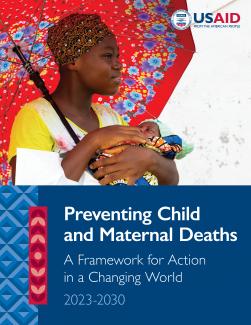Maternal and Child Survival: A Decade of Progress and Action for the Future
A Framework for Action in a Changing World, 2023-2030
Report to congress
For the last 60 years, USAID leadership has been pivotal in advancing maternal and child survival. Since the 2012 Child Survival Call to Action, USAID’s 25 priority partner countries for preventing child and maternal deaths have made significant progress toward the Sustainable Development Goal (SDG) targets for Good Health and Well-Being. Several countries – including Bangladesh, India, Indonesia, Malawi, Nepal, Senegal, Rwanda, and Uganda – are on track to achieve or have already achieved one or more of the SDG targets for child, newborn, and maternal survival. Across all countries, the political will, investments, and learning of this past decade have saved millions of women’s and children’s lives. Yet, many countries are not on track to achieve their SDG targets. Recurring conflict and political strife, poor governance, infectious disease outbreaks, natural disasters, countries’ inability to increase domestic budgets for health, and the reverberating impacts of the global COVID-19 pandemic all impeded progress. Additionally, as we look ahead to the 2030 deadline for the SDG goals, and in the context of a world altered by the COVID-19 pandemic, we need a new framework to guide and prioritize USAID’s maternal and child survival programming toward the investments that will best save lives and promote equity in maternal and child health. Regaining the ground lost during the pandemic and progressing forward to achieve the 2030 SDG targets will benefit from an enhanced focus on delivering primary health care. Primary health care is a central component of all high-performing health systems because it is a vehicle for delivering essential and cost-effective health interventions, including maternal and newborn care; family planning; malaria; nutrition; routine immunizations; and treatment for common childhood illnesses—which can reduce preventable child and maternal deaths. Over the next seven years, USAID will focus on shaping and supporting policies, practices, and country-led programs that improve the quality of care, promote equity, and improve coverage of lifesaving care to reach optimal levels across local communities and regions. USAID’s new strategic framework for preventing child and maternal deaths harnesses the learning and progress of the last decade in six strategic approaches that will yield programmatic improvements and, in turn, save lives.
Together with country and global partners, the U.S. government is working to significantly reduce child and maternal deaths, with the goal of all countries having fewer than 20 deaths per 1,000 live births and fewer than 50 maternal deaths per 100,000 live births by 2035.
A CALL TO ACTION, 2012-2022
In 2012, USAID, in partnership with the United Nations Children’s Fund (UNICEF) and the governments of India and Ethiopia, convened the Child Survival Call to Action to catalyze global commitments to child survival. More than 175 countries and over 400 civil society and faith organizations pledged to sharpen national plans for child survival, monitor results, and focus greater attention on the most disadvantaged and vulnerable children. The same year, complementary efforts in family planning (now known as Family Planning 2030) and nutrition (Nutrition for Growth Compact) launched, generating expanded commitment and collaboration around critical reproductive, maternal, and child health programming. In 2014, USAID unveiled a bold framework, Acting on the Call, to save the lives of 15 million children and 600,000 women by 2020. USAID presented country-specific plans for scaling up interventions, including for maternal and child health, nutrition, family planning, and malaria, that would have the greatest impact on child and maternal mortality rates in priority countries. This integrated, systems-based approach was designed to produce improved and sustainable public health outcomes for women and children. Extensive consultations with bilateral partners, experts, and country leadership informed the 2014 Acting on the Call framework. These global consultations informed the subsequent Sustainable Development Goal targets under goal #3, adopted globally by the United Nations member states in 2015. The 2014 framework placed great emphasis on envisioning a world in which it was possible to accelerate the scale-up of high-impact interventions in maternal and child survival at rates equal to those previously achieved by “best performers.” These projections and targets were set with the optimal conditions for progress in mind. Annual reports tracked progress and explored key challenges and solutions for accelerating progress, including new evidence-based approaches, components of strong health systems, and different dimensions of equity and access. These reports offered an introspective look at opportunities for program design and adaptation. Many of these thematic deep dives are reflected in the new strategic framework for 2023-2030.

